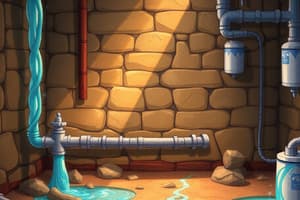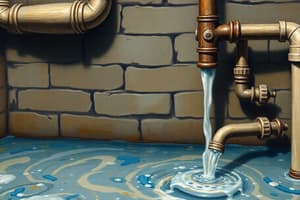Podcast
Questions and Answers
What is the primary purpose of plumbing design in buildings?
What is the primary purpose of plumbing design in buildings?
Which material was primarily used for plumbing in ancient Rome due to its malleability?
Which material was primarily used for plumbing in ancient Rome due to its malleability?
Who invented the flush toilet during the Renaissance Era?
Who invented the flush toilet during the Renaissance Era?
Which plumbing code was approved in the Philippines in 1955?
Which plumbing code was approved in the Philippines in 1955?
Signup and view all the answers
What is the minimum requirement for sanitation in each family dwelling unit on premises connected to a sewer?
What is the minimum requirement for sanitation in each family dwelling unit on premises connected to a sewer?
Signup and view all the answers
What should plumbing fixtures be made of according to the basic principles?
What should plumbing fixtures be made of according to the basic principles?
Signup and view all the answers
Which is NOT a basic principle related to plumbing systems?
Which is NOT a basic principle related to plumbing systems?
Signup and view all the answers
What is the role of NAMPAP in the Philippines?
What is the role of NAMPAP in the Philippines?
Signup and view all the answers
Which period saw the introduction of copper and PVC pipes into plumbing systems?
Which period saw the introduction of copper and PVC pipes into plumbing systems?
Signup and view all the answers
What does the term 'vent terminals' refer to in plumbing systems?
What does the term 'vent terminals' refer to in plumbing systems?
Signup and view all the answers
What is a fundamental requirement of plumbing fixtures in relation to disposal systems?
What is a fundamental requirement of plumbing fixtures in relation to disposal systems?
Signup and view all the answers
Which of the following materials is known for possessing resistance to acid and has been used historically in plumbing?
Which of the following materials is known for possessing resistance to acid and has been used historically in plumbing?
Signup and view all the answers
What action is essential for ensuring the proper functioning of drainage systems?
What action is essential for ensuring the proper functioning of drainage systems?
Signup and view all the answers
Flashcards
Plumbing
Plumbing
The art and science of installing pipes and fixtures to supply and drain water and other substances.
Plumber
Plumber
A skilled person who installs and maintains plumbing systems.
Plumbing History
Plumbing History
Tracing the evolution of plumbing systems from ancient times to modern methods.
Plumbing in Philippines
Plumbing in Philippines
Signup and view all the flashcards
NAMPAP
NAMPAP
Signup and view all the flashcards
Plumbing Objectives
Plumbing Objectives
Signup and view all the flashcards
Basic Plumbing Principle 1
Basic Plumbing Principle 1
Signup and view all the flashcards
Basic Plumbing Principle 2
Basic Plumbing Principle 2
Signup and view all the flashcards
Basic Plumbing Principle 3
Basic Plumbing Principle 3
Signup and view all the flashcards
Basic Plumbing Principle 4
Basic Plumbing Principle 4
Signup and view all the flashcards
Public Sewer Connection
Public Sewer Connection
Signup and view all the flashcards
Private Sewage Disposal
Private Sewage Disposal
Signup and view all the flashcards
Plumbing Fixture Material
Plumbing Fixture Material
Signup and view all the flashcards
Drainage System Design
Drainage System Design
Signup and view all the flashcards
Plumbing Material Requirements
Plumbing Material Requirements
Signup and view all the flashcards
Water Closet Location
Water Closet Location
Signup and view all the flashcards
Study Notes
Engineering Utilities 2 - Plumbing
- Plumbing is the art and science of installing pipes, fixtures, and other apparatus to carry and manage water and other substances in buildings.
- Plumbing systems move water into and out of buildings.
- Plumber is a skilled person in sanitation, derived from the Roman word plumbarius.
- Plumbing uses lead (Pb) as a metal.
- Plumbing materials were crafted from clay, straw, copper, and terracotta initially.
- Early methods included aqueducts, lead piping, flush toilets, and cast iron pipes.
- Modern plumbing uses copper and PVC pipes.
- Plumbing was introduced in the Philippines during the 17th and 18th centuries.
- NAMPAP (National Master Plumbers Association of the Philippines) was created in 1935.
- The Philippines adopted the Plumbing Code for the City of Manila (Ordinance 2411).
- The Philippine Republic Act No. 1378 was legislated in 1955.
- The 1959 plumbing code added asbestos cement piping.
- The Republic Act No. 6541 Building Code in 1972 and a revised National Plumbing Code in 1996 were implemented.
- Basic plumbing principles include supplying water, proper waste disposal, safety, and hygiene standards.
Plumbing Principles
- Principle 1: All habitable premises need clean water.
- Principle 2: Plumbing fixtures have sufficient water at good pressure.
- Principle 3: Plumbing design uses the least water necessary.
- Principle 4: Water heating systems prevent explosions.
- Principle 5: Plumbing in buildings touching roads, alleys, or easements must connect to a public sewer.
- Principle 6: Every house needs at least a toilet and sink for kitchen and sanitation.
- Principle 7: Fixtures are non-absorbent and have smooth surfaces.
- Principle 8: Drainage systems prevent blockage issues like fouling, and have proper cleanouts.
- Principle 9: Pipes need durability and effective workmanship.
- Principle 10: Every plumbing fixture connected to drainage systems has a water seal trap.
- Principle 11: Drainage pipes prevent clogging and provide sufficient air movement.
- Principle 12: Vent terminals need proper air circulation and expulsion.
- Principle 13: Plumbing systems undergo tests for leaks and defects.
- Principle 14: No substance that clogs, explodes, or damages pipes is permitted.
- Principle 15: Protect food, water, and sterile items from sewage contamination.
- Principle 16: Water closets are properly located and ventilated.
- Principle 17: If no sewer is in proximity, a regulated sewage system must be arranged.
NAMPAP Responsibilities
- NAMPAP hosts national and regional plumbing conventions.
- NAMPAP hosts workshops with plumbing experts, tools, equipment, materials, and services presentations.
Studying That Suits You
Use AI to generate personalized quizzes and flashcards to suit your learning preferences.
Related Documents
Description
This quiz covers the essential aspects of plumbing, including its history, materials, and significant regulations in the Philippines. Explore the evolution of plumbing systems from ancient times to modern practices, focusing on key codes and associations. Test your knowledge on how plumbing contributes to sanitation and water management in buildings.




